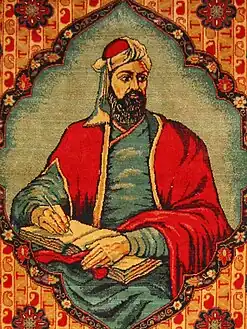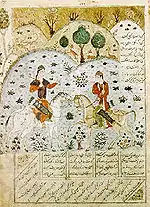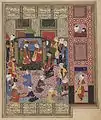نظامي الكنجوي
نظامي الكنجوي (ت. 596 هـ) شاعر مسلم من القرن الثاني عشر.[11][12][13] يعتبر نظامي أعظم شاعر ملحمي رومانسي في الأدب الفارسي، يعود له الفضل في جلب الأسلوب العامي الواقعي للملحمة الفارسية.[14][15] يحظى تراثه بتقدير ومشاركة على نطاق واسع في كل من أفغانستان،[16] جمهورية أذربيجان،[17] إيران،[16] إقليم كردستان[18][19][20] وطاجيكستان.[16]
| نظامي الكنجوي | |
|---|---|
| (بالفارسية: نظامی گنجوی) | |
 | |
| معلومات شخصية | |
| الميلاد | سنة 1141 [1][2][3][4][5] كنجه |
| الوفاة | سنة 1209 (67–68 سنة)[6][1][3][5][7] كنجه |
| مكان الدفن | كنجه |
| الجنسية | |
| الحياة العملية | |
| المهنة | شاعر[9]، وكاتب[10]، وفيلسوف |
| اللغة الأم | الفارسية |
| اللغات | الفارسية |
| أعمال بارزة | خمسة نظامي |
| جزء من من سلسلة مقالات حول |
| نظامي الكنجوي |
|---|
 |
| الكنوز الخمسة |
|
| مواضيع ذات صلة |
|
| معالم ونصب تذكاريّة |
|
|
حياته
وُلد نظامي لعائلة فارسية،[16][21][22][23][24] واسمه إلياس[16] واسمه المستعار المختار هو نظامي. ينحدر من خلفية حضرية من مدينة كنجة[17] الواقعة في الإمبراطورية السلجوقية (جمهورية أذربيجان حاليًا)،[14] ويعتقد أنه قضى حياته كلها في منطقة جنوب القوقاز. ذكر المؤرخ الأرمني كيراكوس غاندزاكيتسي [الإنجليزية] (1200 - 1271) أن كنجة كانت مدينة يسكنها الإيرانيون في الغالب خلال تلك الفترة،[16] كما أشار إلى أنها كانت مكتظة بالسكان بالإيرانيين وأقلية من المسيحيين. لم يكن نظامي شاعرًا في البلاط الملكي لذا فإسمه لا يظهر في سجلات السلالات الحاكمة.[25] تشير التذاكر (وهي مجموعات من المذكرات الأدبية التي تشمل أقوال الشعراء العظماء إلى جانب معلومات السيرة الذاتية) إلى نظامي بشكل مختصر جدًا، تستند الكثير من المواد المذكورة في هذه التذاكر على أساطير وحكايات وإشاعات،[25] وبالتالي لا يُعرف سوى القليل من الحقائق عن حياة نظامي،[17][25] تعتبر أعماله الأدبية المصدر الرئيسي للمعلومات عنه، لكنها لا تقدم سوى القليل من المعلومات عن حياته الشخصية.[17]
تزوج نظامي ثلاث مرات وقد صرح بأن أولى زوجاته كانت تدعي آفاق ومنها أنجب ابنه الوحيد محمد. و قد توفيت هذه الزوجة في عام 581 و هي شابة ففجع بوفاتها لشدة تعلقه بها. ثم تزوج بالثانية التي ماتت هي الأخرى عام 584. فتزوج بالثالثة التي توفيت في عام 599 هـ. و قد أشار الشاعر في تألم إلى زوجاته وفراقهن له واحدة بعد الأخرى في أشعاره.[26]
مكانته
يعتبر نظامي شاعر موهوب، يعترف بها جميع النقاد من الفرس وغيرهم على السواء وقد اعترف له بذلك كتاب التراجم ومن بينهم عوفي وحمد الله المستوفي ودولتشاه سمرقندي ولطف علي بيك وكذلك الشعراء ومن بينهم سعدي الشيرازي وحافظ الشيرازي وعبد الرحمن الجامي وعصمت البخاري.
مؤلفاته
من أشهر مؤلفاته پنج گنج والتي تعني الكنوز الخمسة والتي تتألف من خمسة منظومات قصصية.
- مخزن الأسرار: هي منظومة صوفية تشتمل على كثير من النكات والحكايات على أسلوب حديقة الحقيقة التي ألفها سنائي أو على أسلوب المثنوي المعنوي الذي كتبه فيما بعد جلال الدين الرومي. وهي تشتمل على كثير من المقدمات في المناجاة والحمد، يعقبها عشرون مقالة كل واحدة منها تتعلق بموضوع فقهي أو أخلاقي يتناوله الشاعر أولاً من الناحية النظرية والمعنوية، ثم يصوره بعد ذلك بحكاية من الحكايات.
- خسرو وشيرين: في هذه القصة يجري نظامي على نسق الفردوسي من ناحية الموضوع والصياغة. وموضوع قصته يشتمل على مخاطرات الملك الساساني كسرى الثاني وغرامه مع معشوقته الجميلة شيرين، ونهاية منافسه التعيس فرهاد، وقد اعتمد نظامي في هذه القصة على المصادر التي اعتمد عليها الفردوسي من قبل أو على مصادر أخرى شبيهة بها، ولكنه تناولها بطريقة أخرى، ابتعد فيها عن الدراسة الموضوعية، فاستطاع أن يخرجها قصة غرامية بعكس الفردوسي فإنه أخرجها قصة حماسية. وهذه المنظومة تشتمل على ما يقرب 7000 بيت.
- ليلى ومجنون:و هذه القصة لا تحدث وقائعها في إيران بل تقع حوادثها في بلاد العرب وهي لا تمثل شخصية ملكية، بل تمثل شخصين عاديين من عرب الصحراء أحدهما هو البطل والآخر هو الفتاة المعشوقة. ولكن نظامي استطاع أن يصبغها بالصبغة الفارسية وقد أختار لها وزن الهزج المسدس الأحزب القبوض المحذوف. وتشتمل على أكثر من 4000 بيت.
- هفت پيكر (العروش السبعة): آخر المثنويات التي أنشدها نظامي ويشتمل على أكثر من 50000 بيت من الشعر. وموضوع هذه المثنوية مشابه لموضوع خسرو وشيرين في كونه متعلقا بقصة خاصة بأحد الملوك الساسانيين وهو بهرام جور.
- إسكندرنامه (كتاب الإسكندر المقدوني): هذه هي المثنوية الخامسة من مثنويات نظامي وهي مكتوبة في وزن المتقارب وهو الوزن الذي كتب فيه أكثر الشعر القصصي الفارسي. وهذه المثنوية مقسمة إلي قسمين. الأول منهما يسمي إقبالنامه والثاني يسمي خردنامه.
- ديوان: فان للنظامي ديوان من الغزليات والموشحات والقصائد يبلغ العشرين ألف بيت وقد كتب نظامي ديوانه في سنة 584 ه.
معرض الصور
 الصفحة الأولى من كتاب خسرو وشيرين لنظامي الكنجوي
الصفحة الأولى من كتاب خسرو وشيرين لنظامي الكنجوي الصفحة الثانية من كتاب خسرو وشيرين لنظامي الكنجوي
الصفحة الثانية من كتاب خسرو وشيرين لنظامي الكنجوي صفحة من كتاب خسرو وشيرين لنظامي الكنجوي
صفحة من كتاب خسرو وشيرين لنظامي الكنجوي صفحة من كتاب ليلى ومجنون لنظامي الكنجوي
صفحة من كتاب ليلى ومجنون لنظامي الكنجوي صفحة من كتاب هفت پيكر لنظامي الكنجوي
صفحة من كتاب هفت پيكر لنظامي الكنجوي صفحة من كتاب إسكندرنامه لنظامي الكنجوي
صفحة من كتاب إسكندرنامه لنظامي الكنجوي الصفحة الأولى من كتاب إقبالنامه لنظامي الكنجوي
الصفحة الأولى من كتاب إقبالنامه لنظامي الكنجوي صفحة من كتاب ديوان لنظامي الكنجوي
صفحة من كتاب ديوان لنظامي الكنجوي
روابط خارجية
- نظامي الكنجوي على موقع Encyclopædia Britannica Online (الإنجليزية)
- نظامي الكنجوي على موقع MusicBrainz (الإنجليزية)
- نظامي الكنجوي على موقع Discogs (الإنجليزية)
مراجع
- Nationalencyklopedin | Nezami (بالسويدية), OCLC:185256473, QID:Q1165538
- مشروع مكتبة الموسيقى الدولية | Nizami Ganjavi، QID:Q523660
- Discogs | Nizami (بالإنجليزية), QID:Q504063
- Brockhaus Enzyklopädie | Nisami (بالألمانية), QID:Q237227
- Store norske leksikon | Elyas Yusof Nezami (بالنرويجية البوكمول والنرويجية النينوشك), ISSN:2464-1480, QID:Q746368
- Encyclopædia Britannica | Nezami (بالإنجليزية), QID:Q5375741
- https://www.biografiasyvidas.com/biografia/n/nizami.htm.
{{استشهاد ويب}}:|url=بحاجة لعنوان (مساعدة) والوسيط|title=غير موجود أو فارغ (من ويكي بيانات) (مساعدة) - Nizami Ganjavi (1141-1209) - Find A Grave Memorial نسخة محفوظة 12 سبتمبر 2018 على موقع واي باك مشين.
- أرشيف الفنون الجميلة، QID:Q10855166
- Charles Dudley Warner, ed. (1897), Library of the World's Best Literature (بالإنجليزية), QID:Q19098835
- "ESKANDAR-NĀMA OF NEŻĀMĪ – Encyclopaedia Iranica". Iranicaonline.org. مؤرشف من الأصل في 2018-05-17. اطلع عليه بتاريخ 2014-03-23.
- "ḴĀQĀNI ŠERVĀNI i. Life – Encyclopaedia Iranica". Iranicaonline.org. مؤرشف من الأصل في 2018-07-18. اطلع عليه بتاريخ 2014-03-23.
- "The Teahouse at a Glance" – Nizami's Life and Works, 2000 نسخة محفوظة 04 مارس 2016 على موقع واي باك مشين.
- "Neẓāmī". Encyclopædia Britannica Online. Encyclopædia Britannica. 2009. مؤرشف من الأصل في ديسمبر 4, 2008. اطلع عليه بتاريخ فبراير 28, 2009.
Greatest romantic epic poet in Persian Literature, who brought a colloquial and realistic style to the Persian epic. [...] Nezami is admired in Persian-speaking lands for his originality and clarity of style, though his love of language for its own sake and of philosophical and scientific learning makes his work difficult for the average reader.
- Meisami، Julie Scott (1995). The Haft Paykar: A Medieval Persian Romance. Oxford University Press.
Abû Muhammad Ilyas ibn Yusuf ibn Zaki Mu'ayyad, known by his pen-name of Nizami, was born around 1141 in Ganja, the capital of Arran in Transcaucasian Azerbaijan, where he remained until his death in about 1209. His father, who had migrated to Ganja from Qom in north central Iran, may have been a civil servant; his mother was a daughter of a Kurdish chieftain; having lost both parents early in his life, Nizami was brought up by an uncle. He was married three times, and in his poems laments the death of each of his wives, as well as proffering advice to his son Muhammad. He lived in an age of both political instability and intense intellectual activity, which his poems reflect; but little is known about his life, his relations with his patrons, or the precise dates of his works, as the accounts of later biographers are colored by the many legends built up around the poet
- C. A. (Charles Ambrose) Storey and François de Blois (2004), "Persian Literature – A Biobibliographical Survey: Volume V Poetry of the Pre-Mongol Period.", RoutledgeCurzon; 2nd revised edition (June 21, 2004). (ردمك 0-947593-47-0). p. 363: "Nizami Ganja’i, whose personal name was Ilyas, is the most celebrated native poet of the Persians after Firdausi. His نسبه designates him as a native of Ganja (Elizavetpol, Kirovabad) in Azerbaijan, then still a country with an Iranian population, and he spent the whole of his life in Transcaucasia; the verse in some of his poetic works which makes him a native of the hinterland of Qom is a spurious interpolation." begun by C. A. Storey (Author), Francois De Blois (Author). Persian Literature - A Biobibliographical Survey: Poetry c. A.D. 1100-1225 (Volume V Part 2). Royal Asiatic Society Books. ص. 438. ISBN:094759311X.
{{استشهاد بكتاب}}:|مؤلف=باسم عام (مساعدة) - Jan Rypka (Rypka, Jan. ‘Poets and Prose Writers of the Late Saljuq and Mongol Periods’, in The Cambridge History of Iran, Volume 5, The Saljuq and Mongol Periods, ed., Published January 1968. p. 578: As the scene of the greatest flowering of the panegyrical qasida, southern Caucasia occupies a prominent place in New Persian literary history. But this region also gave to the world Persia’s finest creator of romantic epics. Hakim Jamal al-din Abu Muhammad Ilyas b. Yusuf b. Zaki b. Mu’ayyad Nizami a native of Ganja in Azarbaijan, is an unrivaled master of thoughts and words, a poet whose freshness and vigor all the succeeding centuries have been unable to dull. Little is known of his life, the only source being his own works, which in many cases provided no reliable information. We can only deduce that he was born between 535 and 540 (1140–46) and that his background was urban. Modern Azarbaijan is exceedingly proud of its world famous son and insists that he was not just a native of the region, but that he came from its own Turkic stock. At all events his mother was of Iranian origin, the poet himself calling her Ra’isa and describing her as Kurdish.
- "Nizami Ganjavi - USSR Politicization - Iranian Persian Civilization - Nezami Ganjei". Azargoshnasp.net. مؤرشف من الأصل في 2012-07-07. اطلع عليه بتاريخ 2014-03-23.
- Thomas de Waal. The Caucasus: An Introduction. اطلع عليه بتاريخ 2014-03-23.
- Vladimir Minorsky. Studies in Caucasian History. اطلع عليه بتاريخ 2014-03-23.
- Chelkowski, P.J (1995), “Nizami Gandjawi”, Encyclopaedia of Islam, New Ed., vol. 8: 76–81. Online Version: Chelkowski, P. "Nizami Gandjawi, jamal al-Din Abu Muhammad Ilyas b. Yusuf b. Zaki Muayyad . Encyclopaedia of Islam. Edited by: P. Bearman, Th. Bianquis, C.E. Bosworth, E. van Donzel and W.P. Heinrichs. Brill, 2008. Brill Online. Excerpt one:"Nizami Gandjawi, Djamal al-Din Abu Muhammad Ilyas b. Yusuf b. Zaki Muʾayyad, one of the greatest Persian poets and thinkers." Excerpt two: "In Haft Paykar, the phantasmagoric movement of its hero, Bahram Gūr, as he visits each princess, covers a symbolic path between black, or the hidden majesty of the Divine, and white, or purity and unity. The princesses and their pavilions are manifestations of specific planets, specific climes, colours, and days. The pavilions are domed, representing the structure of the heavens. Nizami illustrates the harmony of the universe, the affinity of the sacred and the profane, and the concordance of ancient and Islamic Iran." (Nizami Ganjavi in Encyclopedia of Islam, Chelkowski)."
- Bernard Lewis, “Music of a distant drum”, Princeton University Press, 2001. Pg 9: “The Persians went a step further, creating authentic epic tradition comparables with those of Greece, Rome and the Vikings. This too, became in time, a form of Persian national self definition. The most famous of Persian epic poets, Firdawsi (940–1020) has been translated several times. An extract from the story of Farhad and Shirin, as told by the 12th century Persian poet Nizami, exmpelified another form of narrative”
- Julie Scott Meisami, Paul Starkeym, “Encyclopedia of Arabic Literature”, Taylor & Francis, 1998. Pg 69: “In Arabic literature there has been no artistic elaboration of the story comparable to that undertaken by the Persian poet Nizami“
- "BACHER, WILHELM – Encyclopaedia Iranica". Iranicaonline.org. مؤرشف من الأصل في 2014-05-17. اطلع عليه بتاريخ 2014-03-23.
- Peter J. Chelkowski, "Mirror of the Invisible World", New York: Metropolitan Museum of Art, 1975. p. 1: "The culture of Nizami's Persia is renowned for its deep-rooted tradition and splendor. In pre-Islamic times, it had developed extraordinarily rich and exact means of expression in music, architecture, and daily life as well as in writing, although Iran, its center—or, as the poets believed, its heart—was continually overrun by invading armies and immigrants, this tradition was able to absorb, transform, and ultimately ocercome foreign intrusion. Alexander the Great was only one of many conquerors, to be seduced by the Persian way of life." p. 2:"During the last quarter of the twelfth century, when Nizami began his Khamsa, Seljuq supremacy was on the decline and political unrest and social ferments were increasing. However, Persian culture characteristically flourished when political power was diffused rather than centralized, and so Persian remained the primary language, Persian civil servants were in great demand, Persian merchants were successful, and princedoms continued to vie for the service of Persian poets. This was especially true in Ganjeh, the Caucasian outpost town where Nizami lived." p. 6: "Nizami's strong character, his social sensibility, and his poetic genius fused with his rich Persian cultural heritage to create a new standard of literary achievement. Using themes from the oral tradition and written historical records, his poems unite pre-Islamic and Islamic Iran", p. 9:"Probably no Persian writer has inspired succeeding generation of poets more than Nizami", p. 6: ""Khosrow and Shirin" proved to be a literary turning point not only for Nizami but for all of أدب فارسي. Furthermore it was the first poem in Persian literature to achieve complete structural and artistic unity". p. 2;"During the last quarter of the twelfth century, when Nizami began his Khamsa, Seljuq supremacy was on the decline and political unrest and social ferments were increasing. However, Persian culture characteristically flourished when political power was diffused rather than centralized, and so Persian remained the primary language, Persian civil servants were in great demand, Persian merchants were successful, and princedoms continued to vie for the service of Persian poets. This was especially true in Ganjeh, the Caucasian outpost town where Nizami lived." p. 1: "By the end of the tenth century, Persian literature was world renowned; it was heralded from the eastern Mediterranean to the banks of the Indus" pp2:"Few facts about the life of Nizami are certain. Because he was not a court poet and it was his poetry rather than his life or his political connections that won him enduring fame, he does not appear in the annals of the dynasties...". p. 9: "The memorization and recitation of their literary heritage has alway beens vital to Iranians, whose attitude towards the power of the written and spoken word is revential. Even today the national passion for poetry is constantly expressed over radio and television, in teahouses, in literary societies, in daily conversation, and in the Musha'areh, the poetry recitation contest. Nizami's work serves as a vehicle and a symbol of this tradition, for it unites universality with deep-rooted artistic endeavor, a sense of justice and passion for the arts and sciences with spirituallity and genuine piety. for richness and fineness of metaphor, accuracy, and profundity of psychological observation, and sheer virtuosity of storytelling, Nizami is unequalled"
- "WebCite query result". مؤرشف من الأصل في 2011-08-12. اطلع عليه بتاريخ 2011-08-28.
{{استشهاد ويب}}: الاستشهاد يستخدم عنوان عام (مساعدة)نسخة محفوظة 14 ديسمبر 2017 على موقع واي باك مشين.
- بوابة أذربيجان
- بوابة أعلام
- بوابة إيران
- بوابة الروحانية
- بوابة شعر
- بوابة فلسفة